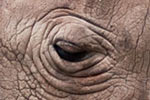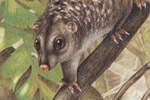
A female common earwig (Forficula auricularia) in defensive posture. The world’s largest earwig has been declared extinct. Photo by: Public Domain.
The world has lost a giant: this week the IUCN Red List officially declared St. Helena giant earwig (Labidura herculeana) extinct. While its length of 80 millimeters (3.1 inches) may not seem like much, it’s massive for an earwig and impressive for an insect.
“The species is large, charismatic and of iconic status on the island; while there is still a slim possibility that it may still persist in some remote location, the balance of evidence points towards the species being extinct,” reads the updated listing of the herculean earwig.
Only found on the island of St. Helena in the remote southern Atlantic, experts believe the St. Helena giant earwig was pushed to extinction by the removal of sheltering stone in its small habitat for construction purposes. In addition, the earwig had to contend with an invasion of predatory mice, rats, spiders, and centipedes on the island.
The St. Helena giant earwig was first described over two hundred years ago—in 1798—by the Danish scientist, Johan Christian Fabricius, a student of Carl Linnaeus. However, confusion over the earwig’s taxonomy left it largely overlooked even by entomologists. The earwig was last seen alive in 1967. But body parts have been collected as recently as this year, although unfortunately these are likely from individuals that died decades ago.
 A specimen of the St. Helena giant earwig in the Jamestown Museum. Photo by: Roger S. Key. |
As one of the most remote islands on the planet, St. Helena was first discovered in the early 16th Century and was totally uninhabited by people. Today, it is a British Overseas Territory. The island is still home to hundreds of endemic species, i.e. those found no-where else. The island is probably most famous as the place of exile for Napoleon.
Earwigs make up the insect order of Dermaptera. Many of them sport large pinchers on their forceps, and the St. Helena giant earwig sported an especially impressive pair. Entomologists have nicknamed the St. Helena giant earwig the “dodo of Dermaptera.”
Research has shown that unlike most non-social insects, earwigs are doting mothers, including ritually cleaning her laid eggs and helping her nymphs hatch. Once out, the earwig mother feeds her nymphs with regurgitated food and allows them to sleep underneath her.
The earwig’s unusual name is thought to come from the disturbingly vivid folk belief that earwigs would burrow into people’s ears and lay their eggs in the brain. But, of course, this isn’t true.
With the extinction of the St. Helena giant earwig, the largest surviving earwig is the Australian giant earwig (Titanolabis colossea), which comes in at around 50 millimeters (just under two inches), a veritable dwarf compared to St. Helena’s.
The St. Helena giant earwig wasn’t the only animals declared extinct in the recent IUCN Red List update. The update also declared a snail on peninsular Malaysia extinct, the Plectostoma sciaphilum. The species was obliterated when a cement company destroyed the only limestone karst on which the species was found.
“These recent extinctions could have been avoided through better habitat protection,” said Simon Stuart, the Chair of the IUCN Species Survival Commission.
Not surprisingly, the announcement of the earwig’s extinction hasn’t garnered much media attention. It appeared at the end of a press release from the IUCN Red List on its latest update, and was covered in a blog on the BBC, but other than that it’s largely gone unnoticed.
Insects—even giant ones—rarely get the kind of attention more “lovable” animals receive. And it isn’t just the media: conservation groups rarely, if ever, talk about or focus their efforts on insects. Despite the fact that insects play huge roles in ecosystems. Even the IUCN Red List has done little work on what is the world’s biggest animal group at least compared to more so-called charismatic groups. While the organization has evaluated 100 percent of birds and mammals, it has evaluated only about 0.5 percent of the world’s known insects.

A non-giant species of earwig with its young in the UK. Photo by: Tom Oates, 2010.
Related articles
It only took 2,500 people to kill off the world’s biggest birds

(11/10/2014) The first settlers of New Zealand killed off nine species of giant birds, known as moas, with a population no bigger than a few thousand people, according to new research published in Nature Communications. The biggest moas stood up to 3.6 meters (12 feet) tall, making these mega-birds the largest animals in the country and contenders for the biggest birds ever.
The Search for Lost Frogs: one of conservation’s most exciting expeditions comes to life in new book

(10/30/2014) One of the most exciting conservation initiatives in recent years was the Search for Lost Frogs in 2010. The brainchild of scientist, photographer, and frog-lover, Robin Moore, the initiative brought a sense of hope—and excitement—to a whole group of animals often ignored by the global public—and media outlets. Now, Moore has written a fascinating account of the expedition: In Search of Lost Frogs.
Saving the survivor: China scrambles to keep the finless porpoise from extinction

(10/22/2014) On the morning of July 14, 2002 Qi Qi ate breakfast as he always did. As the world’s only captive baiji – or Yangtze river dolphin – Qi Qi was something of a celebrity in China and his caretakers kept a close eye on his health. That care may explain why, after being injured by fishermen, he lived an impressive 22 years in the Freshwater Dolphin Research Center in Wuhan, China.
With death of rhino, only six northern white rhinos left on the planet

(10/20/2014) Rhino conservation suffered another tragic setback this weekend with the sudden death of Suni, a male northern white rhinoceros at the Ol Pejeta Conservancy in Kenya. Suni’s passing means there are only six northern white rhinos left in the world, and only one breeding male. ‘Consequently the species now stands at the brink of complete extinction, a sorry testament to the greed of the human race,’ wrote the Conservancy.
Extinction island? Plans to log half an island could endanger over 40 species

(09/22/2014) Woodlark Island is a rare place on the planet today. This small island off the coast Papua New Guinea is still covered in rich tropical forest, an ecosystem shared for thousands of years between tribal peoples and a plethora of species, including at least 42 found no-where else. Yet, like many such wildernesses, Woodlark Island is now facing major changes: not the least of them is a plan to log half of the island.
Is there hope for the vaquita? IUCN calls for action to save world’s smallest, rarest porpoise

(09/19/2014) Since the baiji was declared extinct in the early aughts, the vaquita has taken its unenviable position as the world’s most threatened cetacean. The tiny porpoise currently numbers around 100, with accidental entanglement in gillnets primarily responsible for its decline. In response, the IUCN recently issued a statement calling for immediate action to curb vaquita bycatch and head off its extinction – which otherwise may lie just around the corner.
Thought wiped out by climate change, ‘extinct’ snail rediscovered in Seychelles

(09/09/2014) The Aldabra banded snail was declared extinct in 1997 as one of the world’s first recorded direct casualties of climate change. But last month, a monitoring team found a population on one of the atoll’s islands, surprising the team and giving hope that other species whose habitats are being degraded by climate change may still be able to cling to existence.